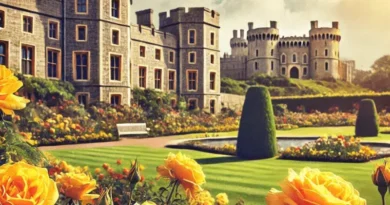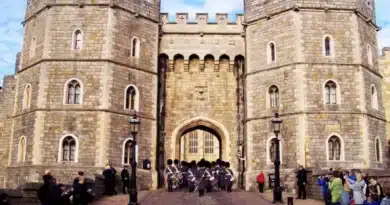Are There Mice in Windsor Castle?
There are likely mice in Windsor Castle, just like in most old buildings. Mice are resourceful, squeezing through small spaces and surviving on minimal resources. However, the Royal Collection Trust is responsible for the castle’s upkeep and implements pest control measures. These methods include traps, bait stations, and exclusion techniques to keep the mouse population in check.
Documented mouse sightings in Windsor Castle are rare. While a scene in the Netflix series “The Crown” depicted a mouse scurrying through the floor (although filmed elsewhere and meant to represent Buckingham Palace), a verified sighting occurred in 2015 at the State Rooms.
As a visitor, encountering a mouse is improbable. The Royal Collection Trust’s efforts likely keep the mouse population at bay.
Let’s dive deeper into “Are There Mice in Windsor Castle?”
Key Takeaways
- Windsor Castle’s Historical Context
- At over 900 years old, Windsor Castle’s vast, aged structure, proximity to the River Thames, and surrounding greenery make it susceptible to mice. Hidden nooks, ventilation systems, and tunnels provide potential entry and nesting points.
- Rodent Evidence
- Historical accounts, sightings, and media appearances, like the 2015 mouse photo and a 2020 appearance in The Crown, confirm sporadic rodent activity. However, sensational reports exaggerate these isolated incidents.
- Mouse Management Strategies
- The Royal Collection Trust employs rigorous pest control, sealing entry points, setting traps, and using advanced technologies like thermal imaging to monitor activity. Sustainable, humane methods are prioritised.
- Broader Implications
- Mice in Windsor Castle highlight the balance between hygiene, historical preservation, and sustainability. Innovations like eco-friendly deterrents and biological control ensure minimal environmental impact.
- Public Perception vs. Reality
- Despite occasional sightings, the castle’s pest control measures are highly effective. The issue reflects common challenges faced by historic buildings rather than neglect.
- Future Outlook
- Adapting to environmental changes and advancing technology ensures Windsor Castle remains preserved for future generations while maintaining its cultural significance.
I. The Setting
A Brief History of Windsor Castle: Age & Vulnerability
Standing proudly for over 900 years, Windsor Castle boasts a rich and layered history. As one of the longest-occupied palaces worldwide, it has witnessed numerous historical events, architectural transformations, and evolving customs. However, this longevity also presents a potential vulnerability: attracting uninvited guests – mice.
The castle’s vastness, spanning 13 acres, encompasses various structures with diverse ages and uses. The oldest sections, like the Round Tower built in the 11th century, possess hidden nooks and crannies conducive to rodent activity. Moreover, modern additions introduce potential entry points through ventilation systems, pipes, and service areas.
Furthermore, the castle’s location along the River Thames creates a natural corridor for wildlife, including rodents. Proximity to wooded areas and gardens further increases the likelihood of encounters. While historic charm is undeniable, these factors combine to create an environment where mice might find opportunities to thrive.
The Layout & Environment: Potential Mouse Havens
Understanding Windsor Castle’s layout and environment is crucial to comprehending the potential havens for mice. The sprawling complex includes State Rooms adorned with tapestries, private apartments used by the Royal Family, kitchens catering to grand banquets, and vast storage areas brimming with historical artefacts.
Each section provides potential food sources and nesting grounds. In kitchens, crumbs might linger despite stringent cleaning practices. Despite climate control, storage areas could harbour forgotten items that are attractive to rodents. Even seemingly pristine State Rooms with plush carpets and antique furniture might offer hidden crevices for nesting.
Moreover, the castle’s extensive network of underground tunnels and passageways adds another layer of complexity. Though meticulously maintained, these hidden spaces could offer undetected pathways for mice to navigate the vast complex.
Food Sources: From Royal Feasts to Crumbs
While it’s tempting to imagine mice feasting on remnants of royal banquets, the reality is likely less glamorous. Food sources for mice within the castle are diverse and often inconspicuous. Crumbs dropped by visitors, insects attracted to light sources, and organic materials used in historical displays can all sustain a rodent population.
Furthermore, the surrounding gardens and parklands provide natural food sources like seeds, berries, and insects. Mice can easily access these areas through discreet gaps in walls or ventilation systems, contributing to their potential presence within the castle walls.
It’s important to note that the Royal Collection Trust, responsible for the castle’s upkeep, implements rigorous hygiene standards and pest control measures. However, the sheer size and diverse environments within the castle make eliminating all potential food sources a continuous challenge.
II. The Evidence – Hunting for Tiny Footprints

With the setting laid out, let’s delve into the evidence – have actual mice ever been seen scurrying through the hallowed halls of Windsor Castle?
Confirmed Sightings: Historical Accounts & Media Appearances
While some might dismiss the notion of mice in a royal residence, documented sightings exist. Notably, a 2015 photograph captured a mouse dashing through the State Rooms, sending shivers down many a history buff’s spine. This wasn’t an isolated incident. In 2020, eagle-eyed viewers of the popular Netflix series “The Crown” spotted a furry guest scurrying across the set designed to resemble Buckingham Palace. While not technically within the castle walls, it sparked conversations about the potential presence of mice in royal residences.
However, historical accounts also reveal encounters with these tiny trespassers. Diaries and letters offer glimpses into past struggles with rodent infestations, particularly in older sections of the castle. While these accounts might lack photographic evidence, they paint a picture of a long-standing battle against uninvited guests.
The Challenges of Mouse Detection: Secretive Creatures & Discreet Solutions
Despite these confirmed sightings, pinning down the true extent of mouse activity within Windsor Castle is challenging. Mice are notorious for their stealthy nature, preferring the shadows and unseen corners. Additionally, the Royal Collection Trust prioritizes discreet pest control solutions to preserve the historical integrity of the castle. This means traditional methods like traps and bait stations might be less visible, further shrouding the true extent of the issue from the public’s view.
Furthermore, the castle’s sheer size and complex layout make comprehensive monitoring difficult. Hidden passageways, sprawling basements, and intricate ventilation systems offer countless potential sanctuaries for mice, making their detection a continuous game of hide-and-seek.
Are the Sightings Exaggerated? Public Perception vs. Reality
News of mice in Windsor Castle often sparks sensational headlines, painting a picture of a rodent-infested palace. However, it’s essential to view these reports with a critical lens. The confirmed sightings represent only a snapshot, and sensationalism can sometimes overshadow the rigorous pest control measures the Royal Collection Trust implemented.
Moreover, it’s noteworthy that mice are common in most buildings, regardless of their grandeur. Focusing solely on Windsor Castle might create an unfair portrayal, neglecting the reality that even the most meticulously maintained structures face pest challenges.
III. Mouse Management – Keeping the Castle Rodent-Free

Windsor Castle may be synonymous with royalty and grandeur. Still, even the most majestic abode must contend with mundane realities like pest control. Let’s explore the strategies employed by the Royal Collection Trust to keep the castle mouse-free:
Strategies for Prevention: Exclusion, Monitoring, & Control
The key to managing potential mouse populations lies in a multi-pronged approach:
- Exclusion: Sealing potential entry points is crucial. The Trust meticulously inspects the castle for gaps, cracks, and vulnerable areas around pipes, ventilation systems, and doors. Sealing these openings with appropriate materials minimizes opportunities for mice to enter the building.
- Monitoring: Strategically placed traps and bait stations act as an early warning system. Regular monitoring activity allows the Trust to identify and address potential infestations before they escalate swiftly. Advanced monitoring tools like thermal imaging cameras can even detect hidden rodent activity in inaccessible areas.
- Control: Discrete and humane removal methods are employed when necessary. The Trust prioritizes techniques that minimize risk to the historical fabric of the castle and the well-being of any captured animals.
The Role of the Royal Collection Trust: Keeping the Castle Mouse-Free
The Royal Collection Trust is vital in safeguarding Windsor Castle, including ensuring its pest-free status. Their dedicated team of experts possesses extensive knowledge of the castle’s unique structure and vulnerabilities. They collaborate with professional pest control companies to implement tailored solutions that respect the historical significance of the building.
Furthermore, the Trust prioritizes sustainability and innovation in its pest management practices. This includes exploring eco-friendly methods like ultrasonic deterrents and natural predators while minimizing reliance on harmful chemicals.
Innovation & Sustainability: Modern Pest Control Methods
Technology is evolving the pest control landscape, and the Royal Collection Trust embraces these advancements. As mentioned earlier, thermal imaging cameras offer unprecedented insights into hidden rodent activity. Additionally, advancements in bait station technology allow for targeted deployment and monitoring, minimizing unintended impacts on other wildlife.
Sustainability is also a key focus. The Trust explores methods like using natural materials for exclusion strategies and employing biological control agents like owls or falcons for outdoor rodent control. These innovative approaches ensure effective pest management while minimizing environmental impact.
IV. Impact & Implications – Balancing History, Hygiene, and Humanity
While the presence of mice in Windsor Castle might spark headlines and intrigue, it’s essential to explore the broader implications and navigate the complexities involved.
Cultural Significance: Mice in Literature & Folklore
Mice are unique in our cultural tapestry, appearing in countless fables, folktales, and literary works. From Aesop’s “The Town Mouse and the Country Mouse” to the beloved Beatrix Potter characters, these tiny creatures embody resourcefulness, adaptability, and even mischief themes. In the context of Windsor Castle, their presence can inspire curiosity and reflection on our relationship with wildlife and the challenges of historical preservation.
Public Health Concerns: Balancing Tradition with Hygiene
Despite their literary charm, unchecked rodent populations can pose public health risks. Disease transmission and property damage are valid concerns. However, balancing these concerns with responsible pest control methods and respect for the historical integrity of the castle is crucial. This delicate balance ensures both the safety of visitors and the preservation of the palace’s heritage.
Future Considerations: Adapting Strategies for a Changing World
Climate change and environmental factors can influence rodent populations and their behaviour. Adapting pest control strategies to respond to these evolving challenges is essential. The Royal Collection Trust continuously monitors developments in sustainable pest management. It incorporates them into its practices, ensuring long-term effectiveness while minimizing environmental impact.
V. Conclusion – Beyond the Headlines
The presence of mice in Windsor Castle presents a fascinating intersection of history, pest control, and cultural perception. While headlines might sensationalize the issue, it’s vital to remember that mice in historical buildings are a common reality. The Royal Collection Trust implements rigorous preventive measures and discreet control methods, prioritizing both pest management and historic preservation. Recognizing the challenges, appreciating the cultural significance, and acknowledging the ongoing efforts are crucial for a balanced perspective.
Responsible reporting plays a critical role in shaping public understanding. Sensationalized headlines can paint inaccurate pictures and raise unnecessary concerns. Instead, focusing on factual information, acknowledging the efforts of the Royal Collection Trust, and exploring broader considerations like cultural significance and sustainability contribute to a more nuanced and informative narrative.
Windsor Castle is a testament to history and continues evolving with time. The constant battle against unwanted guests like mice is just one aspect of preserving its majesty and magic. As environmental and technological advancements emerge, the Royal Collection Trust will undoubtedly adapt its strategies, ensuring the castle’s physical integrity and its continued charm and significance for future generations.
FAQ
Why might mice be attracted to Windsor Castle?
Mice are drawn to Windsor Castle due to its age, hidden nooks, access points like vents and pipes, and proximity to the River Thames and gardens, which provide natural food and shelter sources.
Are other pests common in Windsor Castle?
While the article focuses on mice, other pests such as insects or spiders might also be present, as is typical in large, older buildings. However, rigorous pest control measures help keep them in check.
How does the castle’s location affect its vulnerability to mice?
Its location near the River Thames and surrounded by gardens and wooded areas increases exposure to wildlife, including rodents, as these environments are natural habitats for mice.
Do mice damage historical artefacts in the castle?
Mice could potentially damage artefacts if left unchecked by chewing through materials or contaminating items. This risk is mitigated by stringent pest management practices.
Are visitors likely to see mice during their visit?
Visitors are unlikely to encounter mice due to the Royal Collection Trust’s effective pest control measures and the size of the castle, which allows for discreet management.
Are there environmental measures to control mice at Windsor Castle?
Yes, the Trust explores sustainable options like ultrasonic deterrents, natural predators, and eco-friendly exclusion materials to minimise the environmental impact of pest control.
Do mice pose a health risk to castle residents or visitors?
While mice can carry diseases, the Trust ensures hygiene and safety by employing proactive pest control and monitoring strategies, minimising any health risks.
Are mice more likely to be found in certain parts of the castle?
Mice are more likely to inhabit hidden areas such as storage spaces, kitchens, or tunnels where food or nesting materials might be accessible.
Has climate change affected mouse activity at Windsor Castle?
Climate change can influence rodent behaviour, including breeding patterns and migration, potentially increasing challenges for pest management in historical buildings like Windsor Castle.
Is the presence of mice a common issue in historical buildings?
Yes, mice are a frequent challenge in old structures worldwide due to their small size, ability to adapt, and the presence of numerous hiding and nesting spaces in aged architecture.









